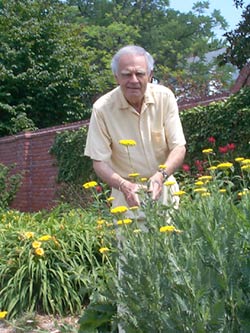
The next time you're using a plant's hardiness zone rating to determine its suitability to your garden, thank Marc Cathey. Marc has dedicated his life to the world of horticulture and making gardeners more successful. He worked for the USDA for 37 years researching the effects of light, temperature and chemicals on plant growth. He also has been the director of the National Arboretum in Washington, DC, for 10 years; president of the American Horticultural Society (AHS) from 1993 to 1997; and president emeritus of AHS since 1997. Marc has authored numerous books and appeared on national television shows, such as the Today Show and Good Morning America. Even with all his prestigious positions, however, Marc is best known for his work with plant zone maps.
USDA Hardiness Zone Map
Fifteen years ago Marc helped spearhead a movement to revise the USDA hardiness zone map. This essential map shows in detail the average annual minimum temperatures that can be expected each year in the United States, Canada and Mexico, and categorizes them into 11 zones. It hadn't been revised for 30 years, and several other hardiness zone maps were in use across the country. Using weather data collected between 1974 and 1986, Marc and his colleagues created the first standardized hardiness map that has gained widespread acceptance. Marc not only helped with the technical aspects of redrawing hardiness zones, he also assisted in securing funding to print and produce the map.
Although the 1990 Hardiness Zone Map has helped countless gardeners and nurserymen with plant selection, a few years ago Marc realized the map needed further updating. The last 10 years have been unusually warm, suggesting some zones should be shifted northward. The first draft of the revised map had the nursery industry uneasy because the changes were considered too dramatic.
"We've been working with the horticulture industry and USDA scientists to decide how many years of hardiness data should be used to redraw the new map," says Marc. "Now we're looking to include data from 8000 different reporting stations over the past 30 years instead of just the past 15 years. The resulting new map should look more like the 1990 map than the first draft," says Marc.
"An equally valid reason for retooling the hardiness zone map is to create an electronic version," says Marc. The 1990 map is widely available in print and online. "However, the new electronic version will be downloadable online," he says. "It will even allow gardeners to download the map by county, giving home gardeners a more accurate view of their hardiness zones." Marc believes the new hardiness zone map will be out sometime in 2005.
AHS Heat Zone Map
Marc Cathey and the American Horticultural Society also led the charge to create a map that categorizes plants not by the absolute cold they can withstand but by the amount of heat they can survive. The AHS Heat Zone Map, published in 1997, has helped gardeners, especially in warmer parts of the country, understand which plants thrive in their summer heat. The 12-zone map indicates the average number of days with temperatures over 86° F (the temperatures at which plant cells suffer physiological damage). Since this map is relatively new, Marc doesn't have plans to revise it soon. "I'd say in 10 to 15 years we will have a new map," he says.
Beyond Maps
Marc contributed to the new edition of the mammoth book, American Horticultural Society A-Z Encyclopedia Of Garden Plants, which has just been published (DK Publishing, 2004; $80). "There are 15,000 plants referenced in the book, with 500 new plants," says Marc. They are all coded with zone ratings. "For the first time we included tropical and semi-tropical plants and turf, complete with hardiness zones," he adds.
Most recently he has turned his attention to another passion: color. A lifelong watercolor artist, Marc is working on a groundbreaking "color book" that will help gardeners match the colors of flowers to colors of furniture, paint and fabrics. "We are standardizing 30 different colors and their companion colors," says Marc. "I want to create a common language of color for gardeners using the new advances in both art and science."
Marc sees other areas of horticulture that need addressing in the future. "We need to leave a clean environment for future generations, and I think horticulture can help," says Marc. He's particularly interested in using plants to clean up toxic waste sites and contaminated soils.
At 76 years old, Marc Cathey also is thinking of future generations of gardeners. He'd like to use art and science to get kids excited about gardening and would love to pen a children's book. Whether it's through maps, research or books, Marc Cathey has given home gardeners valuable tools for becoming more knowledgeable and more successful.
 Charlie Nardozzi is an award winning, nationally recognized garden writer, speaker, radio, and television personality. He has worked for more than 30 years bringing expert gardening information to home gardeners through radio, television, talks, tours, on-line, and the printed page. Charlie delights in making gardening information simple, easy, fun and accessible to everyone. He's the author of 6 books, has three radio shows in New England and a TV show. He leads Garden Tours around the world and consults with organizations and companies about gardening programs. See more about him at Gardening With Charlie.
Charlie Nardozzi is an award winning, nationally recognized garden writer, speaker, radio, and television personality. He has worked for more than 30 years bringing expert gardening information to home gardeners through radio, television, talks, tours, on-line, and the printed page. Charlie delights in making gardening information simple, easy, fun and accessible to everyone. He's the author of 6 books, has three radio shows in New England and a TV show. He leads Garden Tours around the world and consults with organizations and companies about gardening programs. See more about him at Gardening With Charlie.